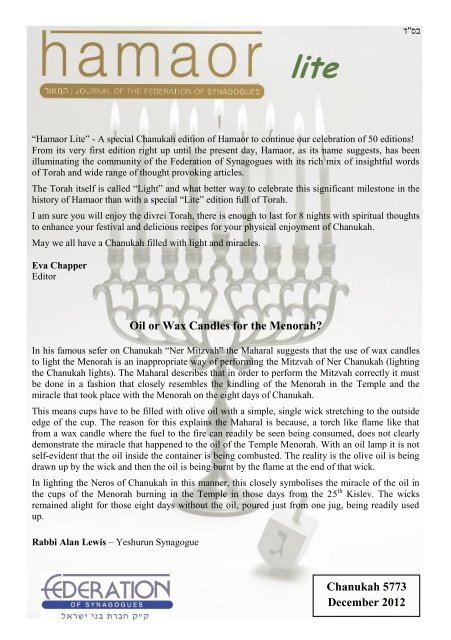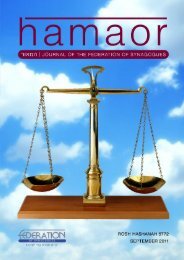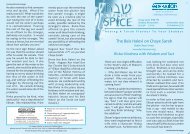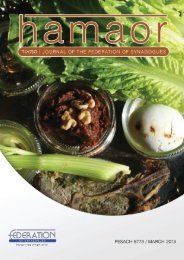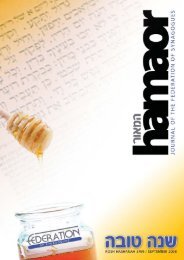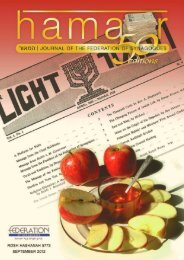Chanucah 5773 - Federation Of Synagogues
Chanucah 5773 - Federation Of Synagogues
Chanucah 5773 - Federation Of Synagogues
You also want an ePaper? Increase the reach of your titles
YUMPU automatically turns print PDFs into web optimized ePapers that Google loves.
בס "ד<br />
lite<br />
“Hamaor Lite” - A special Chanukah edition of Hamaor to continue our celebration of 50 editions!<br />
From its very first edition right up until the present day, Hamaor, as its name suggests, has been<br />
illuminating the community of the <strong>Federation</strong> of <strong>Synagogues</strong> with its rich mix of insightful words<br />
of Torah and wide range of thought provoking articles.<br />
The Torah itself is called “Light” and what better way to celebrate this significant milestone in the<br />
history of Hamaor than with a special “Lite” edition full of Torah.<br />
I am sure you will enjoy the divrei Torah, there is enough to last for 8 nights with spiritual thoughts<br />
to enhance your festival and delicious recipes for your physical enjoyment of Chanukah.<br />
May we all have a Chanukah filled with light and miracles.<br />
Eva Chapper<br />
Editor<br />
Oil or Wax Candles for the Menorah?<br />
In his famous sefer on Chanukah “Ner Mitzvah” the Maharal suggests that the use of wax candles<br />
to light the Menorah is an inappropriate way of performing the Mitzvah of Ner Chanukah (lighting<br />
the Chanukah lights). The Maharal describes that in order to perform the Mitzvah correctly it must<br />
be done in a fashion that closely resembles the kindling of the Menorah in the Temple and the<br />
miracle that took place with the Menorah on the eight days of Chanukah.<br />
This means cups have to be filled with olive oil with a simple, single wick stretching to the outside<br />
edge of the cup. The reason for this explains the Maharal is because, a torch like flame like that<br />
from a wax candle where the fuel to the fire can readily be seen being consumed, does not clearly<br />
demonstrate the miracle that happened to the oil of the Temple Menorah. With an oil lamp it is not<br />
self-evident that the oil inside the container is being combusted. The reality is the olive oil is being<br />
drawn up by the wick and then the oil is being burnt by the flame at the end of that wick.<br />
In lighting the Neros of Chanukah in this manner, this closely symbolises the miracle of the oil in<br />
the cups of the Menorah burning in the Temple in those days from the 25 th Kislev. The wicks<br />
remained alight for those eight days without the oil, poured just from one jug, being readily used<br />
up.<br />
Rabbi Alan Lewis – Yeshurun Synagogue<br />
Chanukah <strong>5773</strong><br />
December 2012
The Power of Hashem<br />
All of our observances of the festivals throughout the Jewish year deal with becoming more aware of<br />
Hashem, acknowledging more and more His presence in our lives, and expressing gratitude to Him. Each of<br />
our festivals however, expresses a different aspect of this awareness.<br />
What is our celebration on Chanukah? Is it not of the נס – the miracle of the victory of Maccabees? But<br />
though Jewish sovereignty was re-established, was it such a great accomplishment? We see from history<br />
that eventually the state leadership was fraught with corruption and the society was far from ideal and<br />
within only a matter of several hundred years the Temple in Jerusalem was destroyed.<br />
The miracle of Chanukah was on a spiritual level and this was emphasised with the miracle of the oil lasting<br />
beyond its material limitations. And indeed in our Amidah prayer of Thanksgiving on Chanukah, it is not so<br />
much the victory of the Maccabees over the Hellenists that is emphasised but rather Hashem's deliverance<br />
of the “strong into the hands of the weak, the many into the hands of the few, the impure into the hands of<br />
the pure”. True power is from Hashem as we read from the Haftarah of Shabbat Chanukah, “Not by (your)<br />
might, not by (your) power, but by My spirit, says Hashem”. When we have this awareness as represented<br />
by the light of the Menorah and pure intention as represented by the purity of the oil, only then are we truly<br />
empowered.<br />
It is this principle that our observance of Chanukah imbues in us, the essence of which existed before the<br />
historical events of the Maccabees. And we can see this in the culmination of the final and eighth day of the<br />
Festival, known as זאת חנוכה which according to our Sages corresponds to Shimini Atzeret – the Eighth<br />
Day of Solemn Assembly. Where seven represents sanctity within the here and now, the number eight<br />
represents transcendence, beyond limits of the physical world of time and space, the miraculous.<br />
The Hellenists did not wish to enslave the body of Yisrael but rather the soul of Yisrael. By transcending<br />
these imposed limitations, through observance of Torah, the generation of the Macabees succeeded in<br />
ensuring the passing on of the flame of Judaism from one successive generation to the next despite all the<br />
ups and downs of our history.<br />
May we merit to continue this miracle. חנוכה משמחת Happy Chanukah<br />
Rabbi Nathan Asmoucha – Croydon & District Synagogue<br />
It Beats Me...<br />
"At the end of two years, and behold Pharaoh dreamt that he was standing by the Nile" [Bereshis 41:1].<br />
Pharaoh is very disturbed by a dream wherein seven skinny cows eat seven fat cows. None of the wise men<br />
of Egypt can interpret the dream for him, and this troubles him even more.<br />
In recent times we have been exposed to politicians of all political persuasions telling us their dreams.<br />
Starting with the success of Martin Luther King Jr.'s famous speech, many party political speeches speak<br />
about dreams for a better future. But we all know that these people did not REALLY have those dreams<br />
while they were sleeping. It is not as if they woke up one morning and said "Wow! I had a dream that would<br />
be perfect to speak about at the next party conference." I am sure that if they truthfully told us their dreams,<br />
we would be less surprised if they really were about seven fat cows and seven thin cows.<br />
It reminds me of the joke we used to play on our teachers at this time of year and ask them the following:<br />
On a recent archaeological expedition in Egypt, seven bovine carcasses were found on the bank of the river<br />
Nile. Which set of cows were they from? After hearing out the logic for why they should have been from<br />
either set of cows, we always had the last laugh and exclaimed "It was a dream!"<br />
Rabbi Shimon Schwab gives us fascinating insight into the psychology of a ruler/dictator. Pharaoh had<br />
probably never lost a fight in his life. His belief was that the strong ALWAYS overpower the weak. "I am<br />
the king. I have the power. I can impose my will on whoever I wish, because no one can do anything against<br />
me and certainly noone will ever beat me."<br />
2
The dream disturbed Pharaoh so greatly because it went totally against his mindset. He felt that it MUST<br />
be telling him something important. It must have foreboded a terrible message. This threatened his power<br />
and he HAD to get to the bottom of it.<br />
Rabbi Schwab takes this one step further and points out that Parshas Miketz and the story of Pharaoh and<br />
his dreams always coincides with Chanukah. It is not a coincidence (nothing ever is!). One of the major<br />
themes of Chanukah is the idea that "the mighty fell into the hands of the weak, the many into the hands<br />
of the few", as we say in the addition of Al Hanissim to the Amidah and Birkas Hamazon. The Makabim<br />
were but a small minority yet they managed to fight off the power and might of the Ancient Greeks and<br />
restore the Beis Hamikdash to its glory.<br />
Rabbi Yehuda Aronovitz – Loughton Synagogue<br />
Fiona's latkes<br />
3 medium potatoes<br />
Small onion<br />
1 tsp salt<br />
Pepper<br />
1/2 tsp sugar<br />
2 eggs<br />
5 tbsp flour<br />
1 tsp baking powder.<br />
Oil for frying.<br />
Grate potatoes and onion, add salt, pepper, sugar and<br />
beaten egg, flour and baking powder.<br />
Fry in hot oil.<br />
Delicious fresh and freezes well too.<br />
Rebbetzin Gitty Aronovitz<br />
<strong>Of</strong> Flames and Souls<br />
HAVE you ever noticed how difficult it is to sit and do nothing? In a waiting room or on a train, we find it<br />
nearly impossible not to search for something to look at or read, as if we need to be constantly stimulated. It<br />
is a phenomenon that suggests a yearning for something beyond our present reality. Judaism calls this<br />
phenomenon the neshamah, the soul that is embedded in us, which is given expression in the story of<br />
Chanukah and our remembrance of past miracles.<br />
The Greeks, who tried to destroy Jews and Judaism based their actions on the philosophy of the physical,<br />
celebrating beauty and elevating logic as the yardstick against which all had to be measured. However, while<br />
Greece taught the holiness of beauty, Judaism teaches the beauty of holiness. This holiness has its root in the<br />
soul, as the verse in Proverbs says, "The candle of G-d is the soul of man,"(20: 27), and it is this idea that<br />
comes to the fore on Chanukah.<br />
The candles we light contain in their simplicity a fundamental concept of Judaism. The flame represents the<br />
soul, the very essence of a person while the candle is the body, just the necessary receptacle. A flame is the<br />
only physical entity that defies gravity: it reaches ever upwards, like the soul of man which constantly strains<br />
for the heavens. The natural state of the soul is to grow and just as the more the flame burns, the lesser the<br />
candle becomes, so, too, the more the soul grows, the more the physical diminishes.<br />
This neshamah phenomenon also contradicts the Hellenistic idea of "what you see is what you get," which<br />
denies the existence of any greater value than surface appearance, while the Jewish view is better<br />
encapsulated by the saying: "There's a lot more than meets the eye." Our immediate reality is not necessarily<br />
the ultimate; so much more is hidden, waiting to be discovered.<br />
3
Candles give this concept expression. One could be forgiven for believing that the wax form of the candle<br />
defines its purpose and is therefore its whole value. Yet when you watch the flame glowing, you realise<br />
that there is something more than just wax. The flame gives light to the world as the soul gives light to the<br />
body, and from this flame a thousand other flames can be lit to create even more light. That ability to give<br />
light is within us all and can be experienced in our relationships with other people.<br />
What do we see when we look at another person? As the commentators explain of the description of<br />
Rachel's beauty, she had an inner beauty and an outer beauty. External qualities are often clearly apparent,<br />
but internal qualities are harder to appreciate. Yet every person has light to bring to the world; it is only<br />
clouded Hellenistic vision that fails to see it. While the world busies itself chasing whatever the eye can<br />
see - and never more so than at this time of year - Chanukah calls out for us to look beyond first<br />
impressions to find deeper value.<br />
The Ponovezher Rav, Rabbi Yosef Shlomo Kahaneman, once asked the following question. After having<br />
lit the Chanukah lights, we recite a prayer, "Al hanisim ve'al hamilchamot," for "the miracles and for the<br />
wars." Why should we thank G-d for wars? Are we bloodthirsty, do we live by the sword, that we are<br />
happy G-d provides wars for us? Would it not have been more appropriate to highlight the victories in<br />
which we vanquished the enemy?<br />
He answered that, in reality, it is premature to thank G-d for the victories because the fight that took place<br />
for the first Chanukah still continues today. The war against the Greeks was mainly a spiritual struggle, a<br />
war of sanctity against defilement that remains as yet to be won and so we thank G-d for the plain fact that<br />
we are fighting, that we strive, despite the most difficult conditions, for something better than our present<br />
situation.<br />
Throughout Jewish history, the battles we have faced have never been simply for the cause of physical<br />
survival: they have always been for higher stakes, the spiritual well-being of our nation. And through all<br />
the enormous tragedies and terrible persecutions our people have undergone, holiness never departed from<br />
us. The flame of the soul that searches for deeper meaning was never extinguished, surely something<br />
worth celebrating, especially today.<br />
Rabbi Alex Chapper – Ilford <strong>Federation</strong> Synagogue<br />
For 25 doughnuts you will need<br />
2.2lbs (1 kilo) flour<br />
1.5 tbsp (50gm) dry yeast<br />
half cup sugar<br />
half teaspoon salt<br />
3.5 cups lukewarm water<br />
Oil for frying and sugar for coating<br />
Moroccan Doughnuts / Sfenj<br />
Mix the flour and yeast in a very large mixing bowl. Add sugar and salt to the mixture and mix. Add half<br />
of the water and knead the dough for one minute with open fingers and by lifting the dough from bottom<br />
to top. Add the rest of the water gradually, kneading for one more minute. The dough should not be<br />
kneaded too much; it should have a loose consistency. Cover the bowl with cling film and leave to rise.<br />
When the dough has doubled in volume, knead the dough to remove air, cover and leave to rise again.<br />
Heat oil for deep frying. Smear your hands with oil (not water). Take a handful of the dough, about the<br />
size of a tangerine, by pulling upwards with one hand and pinching off with the other.<br />
Using your fingers, make a hole in the ball, pulling and stretching to form a doughnut shape.<br />
Immediately drop the doughnut into the hot oil at the side of the pan closest to you, then move the sfenj<br />
(doughnut) away. Continue filling the pan quickly, smearing your hands with oil every now and then. Fry<br />
for about 2 minutes on each side until golden. Remove from the oil and place on paper towels.<br />
Immediately dip in sugar on each side and serve hot.<br />
Note: this may be prepared in a mixer but be sure to knead the dough only a little bit - until the dough is<br />
uniform but not very smooth.<br />
Enjoy…<br />
Rebbetzin Melissa Glass<br />
r<br />
4
בראשית )א ב( וְהָָארֶ ץ הָיְתָה ת ֹהּו וָב ֹהּו וְח ֹשְֶך עַל פְנֵי תְהֹום וְרּוחַ אֱֹלהִים מְרַ חֶפֶת עַל פְנֵי הַמָיִם:<br />
And the earth was unformed and void, and darkness was upon the face of the deep, and the<br />
Spirit of G-d hovered over the face of the waters.<br />
The Midrash (Ber. Rab. 2 4) sees in this verse an allusion to the future history of Israel and<br />
refers to the four exiles which the Jewish nation would have to endure before the coming of<br />
Moshiach. The Midrash expounds “and darkness” is the Greek exile, which darkened the eyes<br />
of Israel with its decrees ordering Israel “write on the horn of the ox that you have no portion<br />
in the G-d of Israel”.<br />
The reference to writing on the horn of the ox is obscure and a selection of interpretations is<br />
offered below:-<br />
1. Rav Yitzchok Yaakov Reines (quoted by Kohelet Yitzchok) refers to the three headings of<br />
damages of an ox stated in the mishna (Bava Kama) – ‘keren’ (horn), ‘shein’ (tooth) & ‘regel’<br />
(foot). The unique features of keren are that it intends to harm even though it does not gain<br />
from its act. This was the nature of the Greek decrees in banning brit mila, Shabbat<br />
observance, and learning Torah (as per Maharsho R.H. 19a).<br />
2. Maharal (Ner Mitzvah) sees in this Midrash a reference to the sin of Israel in worshiping the<br />
golden calf.<br />
3. Megaleh Amukos (parshat Mikeitz) sees an allusion to the sale of Yoseph. Yoseph is, of<br />
course is referred to as ‘bechor shor’.<br />
4. Rav Leib Gurwitz quotes from Shabbos 36a that the shofar is not considered muktzeh as it<br />
can be used as a substitute for a baby’s milk bottle, (such an item is to be found in the British<br />
museum). The Greeks wanted to destroy the Jewish religion by attacking the educational<br />
system which starts with the education of tiny babies. The statement Israel “write on the horn<br />
of the ox that you have no portion in the G-d of Israel” alluded to the desire of the Greeks to<br />
obliterate the tiny children’s education.<br />
5. I once heard from Rabbi Fabian Schonfeld that the Greeks were skilled in advertising.<br />
Today, if a political party or a business enterprise wishes to market their product, one of the<br />
most effective means of advertising would be to use a medium which reaches the maximum<br />
number of people say on the back of a bus or in the underground stations where the public is to<br />
be found. Oxen were used in those days as a means of transport so the Greeks utilised the best<br />
form of advertising media to influence the people.<br />
6. It is quoted in the name of Bnei Yissoschor and similarly expounded by Megaleh Amukos<br />
that the reference to writing on the horn of the ox is referring to the ruling stated in B.Kama<br />
37a that an ox of a Jew goring for the first time the ox of a non-Jew incurs a payment of only<br />
50% of the damage caused whereas in the reverse the non-Jew is required to pay to the Jew full<br />
damages. This naturally caused ill-feeling.<br />
The Talmud relates that two officers were sent to the sages of Israel to learn Torah. They<br />
confessed their approval to all the Torah teaching with the sole exception of the inequitable<br />
damages paid between Jew and Gentile when an ox gored. Yam shel Shlomo queries why the<br />
Rabbis did not change the ruling to prevent potential attacks from the gentile rulers. He<br />
answers that to change a ruling in the Torah was not possible even at the cost of potential loss<br />
of life. This matter is on par with the three cardinal sins of murder, immorality and idol<br />
worship against which saving life does not have priority. He distinguishes this case from the<br />
textual changes made by the Sages in the Septuagint, which were made to avoid<br />
misunderstandings which could lead to heresy.<br />
Rabbi Chaim Zundel Pearlman -<br />
Machzikei Hadath Synagogue & Rosh Beit Midrash Hendon<br />
5
One of the more famous halachos of Chanukah is אין זקוק לה ,כבתה if the lights of the<br />
menorah are extinguished one need not relight them in order to fulfil the obligation of Ner<br />
Chanukah. This holds true even if they were extinguished during the half-hour period during<br />
which the candles should burn. As long as one put in sufficient oil to ensure that they could<br />
have remained alight one has fulfilled the mitzvah. The meforshim are bothered by the<br />
rationale behind this. Why did Chazal take such a lenient stance and not require the<br />
relighting of the menorah? It is after all a mitzvah which comes once a year, a mitzvah which<br />
we merited through tremendous self-sacrifice and an act which is relatively easy to do? The<br />
Bnei Yissoschar explains that the exemption to rekindle the lights represents the entire<br />
message and essence of Chanukah!<br />
The Menorah and its light represent חכמה - wisdom, specifically the wisdom of Torah. One<br />
of the great differences between other wisdoms and Torah wisdom is in the event that a<br />
person is unsuccessful in grasping or understanding that particular wisdom. When it comes<br />
to, for example, mathematics, physics or engineering, if a person makes a mistake and comes<br />
up with a theory which is false, although his efforts may be commended he has not<br />
accomplished what he set out to do. He has arrived at an inaccurate or untrue conclusion and<br />
has not understood the mathematics or the engineering. The wisdom of Torah, however, is<br />
very different in this respect. Chazal say in several places that someone who sincerely tries<br />
to engage in Torah study and does not succeed in attaining an accurate understanding of that<br />
particular concept has nevertheless successfully accomplished the mitzvah of Talmud Torah.<br />
In addition to merely accruing knowledge, the mitzvah is to immerse oneself and endeavour<br />
to understand what the Almighty wants from us. One who is not successful in attaining an<br />
‘enlightening’ pshat is on par with one who has attained an ‘enlightening’ pshat. [The<br />
Maharal says a similar idea when explaining the text of the first of the two birchos haTorah<br />
– לעסוק בדברי תורה recited in the morning. The words which Chazal choose for us to say are<br />
to be involved in divrei Torah as opposed to ללמוד את התורה – to study Torah. Had that been<br />
the required text, it would have indicated that one only fulfils the mitzvah in the event that<br />
לעסוק בדברי תורה accuracy. one was successful in grasping the knowledge with precision and<br />
- to engage and involve oneself with divrei Torah clearly has a different connotation.] That<br />
is what Chazal were hinting to when they said אין זקוק לה ,כבתה if the light goes out one need<br />
not rekindle the flame! The light which is generated by the one with the mistake is equal to<br />
the light generated by the one without the mistake.<br />
This idea is anathema to the Greek mind and its perception of wisdom. If one can<br />
demonstrate a mistake made, how can one possibly still say they have accomplished or<br />
succeeded in that wisdom? This is part of the ongoing battle between כלל ישראל and the<br />
legacy of the Greeks. It is a battle which unfortunately has not been totally resolved and our<br />
victory over the Greeks remains somewhat incomplete. Through our continued Torah study,<br />
.ה‘ - the earth will be filled with knowledge of כי מלאה הארץ דעה את ה‘ may we merit a time<br />
אז אגמור בשיר מזמור חנוכת המזבח . complete. That will be the time when the battle will be<br />
ibaaR Yaakov Hamer – Finchley Central Synagogue<br />
6
“The mitzvah of lighting the candle of Chanukah is an extremely beloved mitzvah” (Rambam, Hilchot<br />
Chanukah 4:12).<br />
This is a puzzling statement. Firstly, it is placed in a halachic work and yet it does not seem to be a<br />
statement about how to actually perform the mitzvah. Secondly, although it is clearly a good thing for<br />
any mitzvah to be beloved, why is this concept specially mentioned only in relation to the mitzvah of<br />
lighting the menorah?<br />
The Syrian-Greek oppression of the Jewish people at the time of Chanukah is one of the four exiles that<br />
the Jewish people is destined to endure over the course of history (Bereishit Rabbah 2:5). It was,<br />
however, a unique exile. It was an exile during which we lived in the land of Israel and during which the<br />
Beit Hamikdash/Temple was standing and, for the most part, functioning. In what sense, in fact, was it<br />
exile at all?<br />
A key to answering these questions lies in a phenomenon of this exile which had existed in no previous<br />
exile. In this exile a societal group known as the “mityavnim” developed. These were Jews who<br />
jettisoned their Judaism and adopted Greek culture. Jews who had assimilated. This was entirely new. In<br />
the exile of Babylon, for example, there had been no “mitbavlim”, no Jews to speak of who had adopted<br />
the mores of Babylonian society.<br />
This leads us to understand that at the root of the exile of Chanukah was not a physical attack on the<br />
Jews or the Beit Hamikdash, but rather an attack on the very identity of the Jews as Jews. We sing in<br />
Maoz Tsur, “they made impure all the oil” that was used for the menorah. They did not destroy it or<br />
pour it away. They just made it the same as all other oil and stripped it of its sanctity.<br />
If the Greek exile of Chanukah was an assault on our identity as Jews, then it needed, primarily, to be an<br />
assault on the Torah itself. As Rav Saadiah Gaon (882-942 CE) famously said, “The Jewish nation is a<br />
nation by virtue of the Torah”. This assault had begun even before the events of Chanukah, when the<br />
Torah had been translated by order of Ptolemy Philadelphus (Talmai), one of Alexander the Great’s<br />
successors. This was a seemingly innocuous event and yet Megilat Taanit says that its effect was that<br />
“darkness came to the world for three days”. The act of translating the Torah was an attempt to turn<br />
Torah from something sacred into a “world classic”, something interesting and academically fascinating<br />
yet devoid of spiritual content. And then, at the time of Chanukah itself, the study of Torah was<br />
outlawed. The very first goal of the Syrian-Greeks mentioned in the Al Hanissim prayer is “to make<br />
them forget your Torah”.<br />
But, as we know, we overcame this exile. The joy of Chanukah, therefore, stems from the fact that we<br />
regained access to our identity as a nation, through regaining access to Torah. The illumination of the<br />
Menorah itself is symbolic of the light of Torah.<br />
Now we can understand the comment of the Rambam, singling out the mitzvah of the Menorah as<br />
“beloved”. The learning of Torah is a unique mitzvah. The blessing made over the learning of Torah is<br />
the only blessing over a mitzvah that contains a prayer that the mitzvah should be sweet or delicious:<br />
“please sweeten...the words of your Torah in our mouths”. Further, the only mitzvah where our own<br />
desire is decisive in our choice of how to perform the mitzvah is the mitzvah of learning Torah: “A<br />
person should learn the Torah which his heart desires” (Avodah Zarah 19a). Sweetness, pleasure, is an<br />
intrinsic part of the mitzvah of learning Torah. It is the very medium through which we learn, much as<br />
light is the medium through which we see and sound waves the medium through which we hear.<br />
Therefore the mitzvah of lighting the menorah, which celebrates regaining access to Torah, is<br />
intrinsically sweet, intrinsically beloved. Unlike most mitzvot, where the love of them is ideal but not<br />
essential, here the beloved-ness lies at the heart of the lighting of the menorah and at the very heart of<br />
Chanukah itself.<br />
[Based loosely on Pachad Yitzchak Chanukah: 6 by R Yitzchak Hutner zs"l.]<br />
Rabbi Daniel Glass – Shomrei Hadath Synagogue<br />
7
Chanukah in Numbers<br />
Rabbi Elazar Ben Chisma taught that the calculation of the gematria are the desserts of wisdom. (Pirke<br />
Avot 3). Simply put a gematria is a system of assigning numerical value to a word or phrase, whereby<br />
each letter of the alef beit represents a number. Alef = 1, Beit = 2 etc. Many of the greatest Sages use<br />
gematria to teach allusions and reinforce messages. The very name Chanukah lends itself to this form of<br />
study. The gematria 25 serves as a perfect example. The first night of Chanukah begins on the 25th of<br />
Kislev because that is the day the Maccabees reclaimed and rededicated the Temple after defeating King<br />
Antiochus’ Syrian army.<br />
Chanukah means “dedication.” But if we look at the word through gematrian-glasses, the word can be<br />
split into two words, Chanu, which means “they rested” and kah, which is comprised of the Hebrew<br />
letters, kaf and hei. kaf = 20, hei = 5, giving us a sum of 25. So we could re-translate the word Chanukah<br />
as “On the 25th of Kislev they rested from their enemies.”.<br />
It is well know that the 25th word in the Torah is ohr, which means “light”. In addition when the Jews<br />
travelled in the desert, on their way from Egypt to the promised land, the twenty-fifth place that they<br />
camped ("rested") was Chashmonah. A clear allusion to the priestly family of Chashmonaim who led the<br />
Maccabee armies in the battle against the Greeks, and rested on the twenty-fifth day of Kislev. (Bamidbar<br />
33:29). But let us go a little deeper.<br />
I recently managed to purchase “Leorah Shel Torah” a book no longer in print penned by someone call R’<br />
Yaakov Auerbach. It is by far the most astounding work with phenomenal novel and unique calculations<br />
of numbers in Jewish thought. Each one of them number perfect. The Chanukah represents the menorah,<br />
which in turn represents the light of Torah as King Solomon said Ki Ner Mitzva V'torah Or.. a candle<br />
represents a mitzvah and the Torah is like light. R’Auerbach firstly shows how there is a powerful<br />
correlation between the lights of the Chanukah and the Torah itself.<br />
Every day we recite 2 blessings. The first lehadlik ner shel-chanuka (counted as one word) contains 13<br />
words. So does sheasa nissim, the second blessing. 26 words over 8 days = 208 words. In addition, on the<br />
first day we recite the bracha of shehechiyanu – which contains 11 words. Giving us a total of 219.<br />
After the lighting of the lights we recite the prayer of hanierot halalu which has some 49 words. 49 x 8<br />
days = 392. 392 + 219 = 611. The number 611 is the exact numerical value of the word Torah.<br />
(400+200+6=5). In addition, he found a beautiful numeric support for this idea. There are of course 613<br />
Biblical commandments. However in addition to the Torah's mitzvot, there are 7 Rabbinic mitzvot. This<br />
brings the total number of mitzvot to 620, a number also indicative of Torah and Mitzvot. The number 620<br />
is also the numeric value of the word Keter, crown. We constantly refer to the Crown of Torah. And by<br />
the way, the numeric value of Keter Torah is 620 + 611 = 1231.<br />
The number happens to be the Gematria of Aseret Hadevarim (the Ten Commandments) =<br />
70+300+200+400 (970) + 5+4+2+200+10+40 (261) = 1231. And for the record, the Ten Commandments<br />
in the Sedra of Yitro, are made up of ….. 620 letters!<br />
Finally and by no less amazingly, R’Auerbach points out that in the sedra of Teruma where the command<br />
to make the Menorah is found, the passage dealing with the Menorah consists of 483 letters. So far this is<br />
insignificant.<br />
However in the beginning of Parshat Tetzaveh, the sedra begins with the instructions about what to do<br />
with the Menorah. The opening verses of Tetzaveh continue the discussion of the Menorah. These verses<br />
contain…. 137 letters.<br />
Total letters on the topic of Menorah? 620. Go figure!<br />
Happy Chanukah to all!<br />
Rabbi Raphael Garson – Ohr Yisrael Synagogue, Elstree<br />
FEDERATION OF SYNAGOGUES, 65 Watford Way, London, NW4 3AQ<br />
T: 020 8202 2263 F: 020 82036610<br />
www.federationofsynagogues.com<br />
Printed by EXCO DPS Ltd, Edgware – Tel: 020 8958 7000


